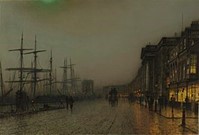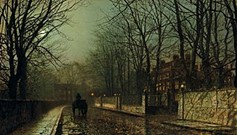| April 22 | May 22 | June 22 |
| September | October | November |
| December | January | February |
| March | April 23 | May 23 |
| June 23 | Reports |
COMPLETED – April 2022
Atkinson Grimshaw – Master of Moonlight
By Alexandra Epps

The Victorian artist Atkinson Grimshaw can be described as a visual equivalent of Charles Dickens, without the political commentary. He had no artistic background and he worked for a time on the railway in Leeds. However, after studying at Leeds library he experimented with new techniques.
He absorbed many influences even from his early years when he observed nature such as primroses in the woods of the leafy suburb he lived in. Other influences were the Pre-Raphaelites like John William Inchbold so nature was central to Grimshaw’s art. He painted in the Lake District and his art became very atmospheric with the misty tones on Lake Windermere and other landscapes. He worked in the principle of John Ruskin with rainbows and spectrums in the sky. He used photography as an aid to help him paint such as a photograph by Thomas Ogle which Grimshaw used as a basis for his painting but adding lily ponds and a heron. A lone heron is depicted in many of his paintings. His portrayal of Ghyll Beck in Yorkshire brings the scene to life with his water painting and the tiny primroses on the banks. He experimented with moonlight at night as shown in “Whitby Harbour by Moonlight” painted in 1867 where the water seems transparent against the harsh shadows.

He painted lanes, with a lone girl walking down a lane in 18th century dress, where the light leads us into the mist. Grimshaw was inspired by Tennyson’s poetry such as “The Deserted House” when trying to evoke the atmosphere in his paintings. He enjoyed great popularity and painted prolifically so, for a while, he could afford the trappings of wealth.
Unfortunately, through a poor investment he was in debt so he moved south to paint London scenes. His use of light in all of these is extraordinary. With the rise in trade, there was a demand for paintings of docks and he produced paintings of, for example, Liverpool Docks, still with glowing moonlight. At the end of his life he returned to drawing the lone figure walking down a road but the person seems to be walking into snow and oblivion. All of his paintings have an air of mystery.

